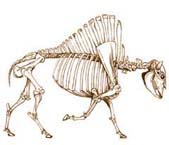Ancient bison bones supports theory about Ice Age seafarers being first in Americas
 Ottawa, March 25 : A series of discoveries of ancient bison bones in Canada and the US have fuelled speculations among researchers that the first settlers in the New World arrived some 14,000 years ago, which is much earlier than the prevailing scientific theory.
Ottawa, March 25 : A series of discoveries of ancient bison bones in Canada and the US have fuelled speculations among researchers that the first settlers in the New World arrived some 14,000 years ago, which is much earlier than the prevailing scientific theory.
According to a report by the Canwest News Service, a total of fourteen separate finds were made of the extinct species “bison antiquus” on Vancouver Island and nearby Orcas Island in Washington State.
These discoveries show that the islands were once part of a coastal grassland refuge from the glaciers that enveloped the rest of Canada and the northern U. S. 14,000 years back.
Among the relics found in areas including the Saanich Peninsula is a particularly tantalizing piece of evidence: a leg bone from Orcas Island that appears to have been butchered by a human - hundreds of years before humans were thought to have migrated to North America.
This finding adds credence to a controversial theory that ancient seafarers, travelling by boat along the ice-fringed B. C. coast, launched the peopling of the New World about 15,000 years ago.
The Vancouver and Orcas islands discoveries also indicate that these pioneering hunters could have relied on much more than seafood to subsist in their new North American home, according to Michael Wilson, an archeologist at B. C.'s Douglas College.
Whether based on seafood or bison meat, the picture of shoreline hunters sketched out in the emergent "coastal migration" theory challenges a long-held view that the earliest newcomers to North America were big-game hunters who arrived about 12,500 years ago from Siberia.
According to this theory, these newcomers pursued mammoths and other ice age prey across the dried-up Bering Strait to Alaska and Yukon, and eventually into the warmer continental interior through an ice-free corridor east of the Rocky Mountains.
These hunters used a distinctive spear-tip known as a Clovis point to kill their prey, and Clovis archeological finds throughout North America show there was a rapid spread of these people and their hunting technology once the glaciers began disappearing around 10,000 B. C.
But the theory has increasingly come under fire from critics who point to numerous archeological sites in both North and South America that appear to have human artifacts from well before 13,000 years ago.
Now, a team headed by Texas A&M University anthropologist Ted Goebel, concluded that both the coastal and ice-free corridor migrations probably occurred.
But their study tilts the crucial matter of identifying the "first" wave of North Americans toward the coastal migrants, and sets the date of that arrival back about 2,000 years before the Clovis hunters reached this continent. (ANI)